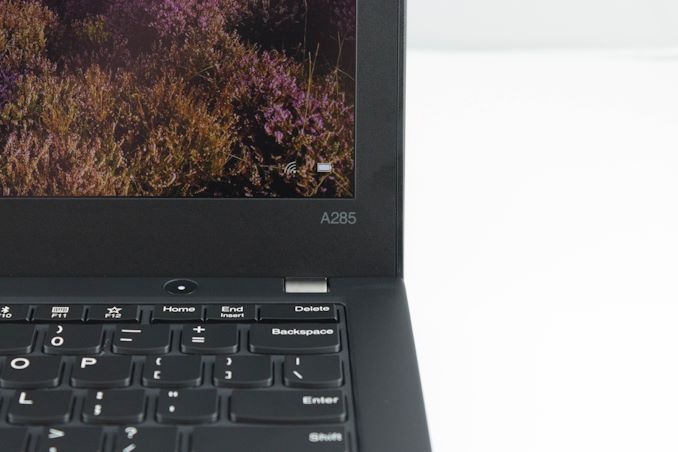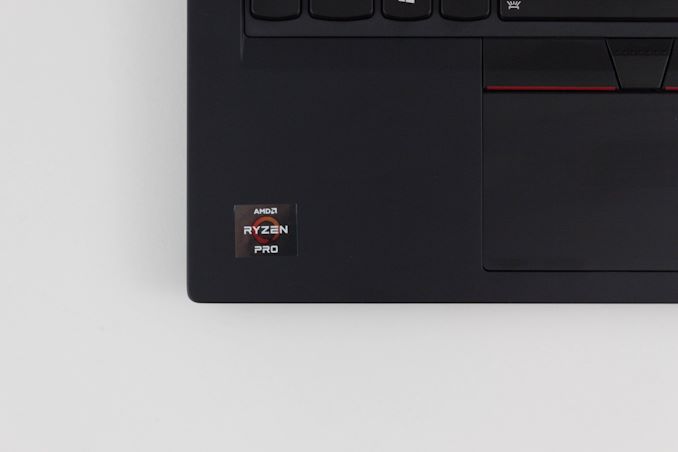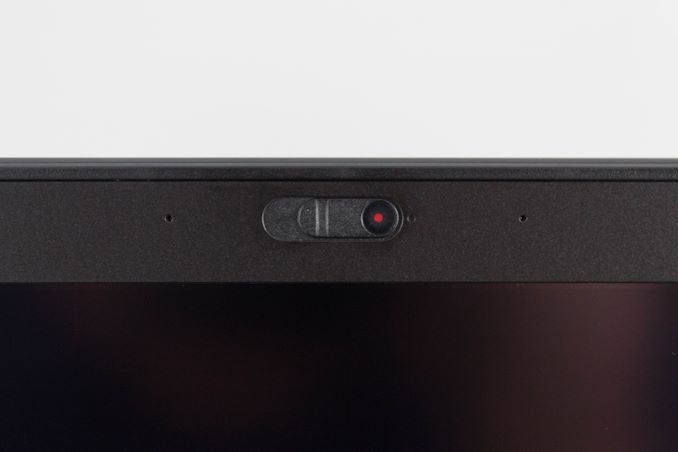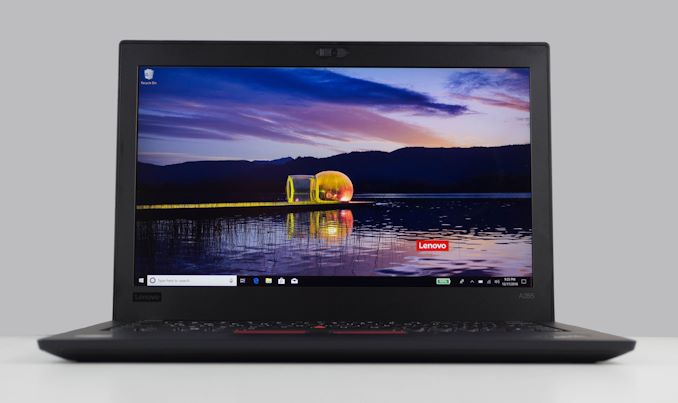The Lenovo ThinkPad A285 (12.5-Inch) Review: Ryzen Pro Gets Down to Business
by Brett Howse on December 18, 2018 8:00 AM EST- Posted in
- Laptops
- AMD
- Lenovo
- ThinkPad
- Vega
- Ryzen
- Ryzen PRO
- Ryzen Mobile
- Vega Mobile
Final Words
If you are in the market for a premium business-class Ultrabook featuring AMD’s Raven Ridge platform, Lenovo has you covered with the ThinkPad A285. The build quality is as superb as you’d expect in a ThinkPad, and it offers a great keyboard with a thin and light design. The ThinkPad look is iconic, and despite the A285 not being as leading edge as Lenovo’s X1 Carbon design, the A285 offers a great build for far less than what an X1 Carbon costs.
It would be nice to see Lenovo ditch the low-end 1366x768 TN display option, even though there is likely demand for it by people buying in bulk for other people to use. But in practice the 1920x1080 IPS should be a pretty easy upsell; it offers a much higher resolution, along with an anti-glare coating, and touch support, making it a rather compelling option. The color accuracy of the IPS display is only average, but that is likely not a huge issue for the target demographic for this device.
It’s unfortunate to see this chassis move away from the removable dual-battery system. Dual batteries were a great idea, since you could easily swap out the battery without shutting down the machine. But Lenovo likely has metrics on how often that was used, and you can generally get a larger battery in less size if you go with a non-removable model. As a business machine, parts should not be an issue either.
Lenovo offers great connectivity with the ThinkPad A285, including two USB-C Gen 2 ports, an integrated Ethernet connector, and a clever combination of the Ethernet and USB-C port to offer a docking option. There’s no SD card reader, but there’s likely not a huge demand for that in a laptop not aimed at photographers. Lenovo does cover the business requirements with a fingerprint reader, as well as a smart card reader.
The performance of the Raven Ridge-based AMD Ryzen 5 Pro 2500U is not spectacular though, and even the kind of performance advantage you'd expect from an AMD iGPU are not really there with the Vega 8 iGPU. Although on the whole the overall performance is more than adequate for plenty of office tasks. The 8 GB of RAM is enough for today for the type of tasks you’d likely perform on a 12.5-inch laptop, but it would really be nice to see a build-to-order 16 GB option on Lenovo’s site as well. The larger 14-inch A485 does offer up to 32 GB.
The biggest thorn in an otherwise solid laptop is probably AMD’s platform power draw. We’ve only tested two Raven Ridge laptops so far, but the idle power draw of each was remarkably consistent, falling within 40 mW of each other. And at over 4.5 Watts, it's just too high, causing significantly higher battery drain than their competitors. This, coupled with the 48 Wh battery in the ThinkPad A285, means that we achieved battery runtimes that were well below the category average. That’s not ideal for a device that is so easily portable. Lenovo offers this same chassis with the Core i7-8650U, and undoubtably the battery life would be significantly better with the Intel platform.
Despite the issues with AMD’s mobile platform, there’s little doubt there is demand for their products, and for those in the market for a well-built Ryzen Mobile laptop, it’s hard to look further than this. If your business is interested in devices with DASH support, AMD’s Ryzen Pro series has you covered with open-source device management, comparable with Intel’s vPro offerings. Lenovo is offering a great product featuring AMD Ryzen, with a quiet and reliable design, plenty of business features, and a laptop that is incredibly easy to travel with. Hopefully AMD can sort out its power issues soon, and make their product more competitive in such a competitive design as this Lenovo ThinkPad A285.














72 Comments
View All Comments
MonkeyPaw - Tuesday, December 18, 2018 - link
I agree. I have a hihg-DPI Lenovo that I dock, and when I undock, I get blurry fonts in Office because my desktop monitor is old-DPI. I’d have to log out and back in each time I docked and undocked, which is not a convenient thing to do going from my desk to a 1 hour meeting and back. We run Windows 10, but we stay a few versions back for testing/stability (I assume).GreenReaper - Tuesday, December 18, 2018 - link
They've had the TN 1366x768 screens for years - I'm using one now (albeit with several other better ones plugged in). It works, but it's pretty bad colour-wise and the low resolution is why sites still need to be designed for such resolutions: they're still sold, new.Spunjji - Tuesday, December 18, 2018 - link
Why do OEMs keep putting capable processors in a chassis with terrible thermal management? If the CPU can't even hit its base frequency under load and yet is *below TDP* then something is very badly wrong with the design.That plus the terrible WiFi seems like unnecessary own-goals. It's a shame. AMD have a lot of work to do to catch up on idle power draw, but they're never going to get the investment necessary if their processors only ever get crammed into half-baked products.
johnny_boy - Tuesday, December 18, 2018 - link
A shame about the idle power draw coupled with a small battery. The screen also sucks but at least it can be upgraded. I was surprised at the performance difference of the iGPUs in the 2500u and 2700u, especially since the CPU tests often ran worse on the 2700u. I wish there were more 2700u laptops available, because that is the sort of iGPU performance I am looking for. And with pretty darn good linux driver support, Ryzen is very enticing (for someone like me).mczak - Tuesday, December 18, 2018 - link
There is just about zero GPU performance difference between a 2700U with Vega 10 and a 2500U with Vega 8 (ok not quite zero but it's tiny). Just about any significant difference between these two comes down to the actual implementation, that is configured TDP, thermal limits, cooling.And apparently Lenovo blew this completely on this notebook.
sfwineguy - Tuesday, December 18, 2018 - link
Sorry to miss something obvious here, but why (per the graphs) did the 2700u underperform the 2500u in some of the CPU tests? Doesn't that confound expectations? Is the 2700u reviewed in another piece that explains how its little brother beats it up in some tests?MonkeyPaw - Tuesday, December 18, 2018 - link
Probably better cooling in the Lenovo, allowing the CPU to stay boosted higher and more often.YukaKun - Tuesday, December 18, 2018 - link
"It would be nice to see a 16 GB offering, but for office tasks, 8 GB should suffice."Oof... That couldn't be more wrong, my dear Brett. The amount of bloatware *cough*McAffee*cough* is just bonkers. 8GB is the *minimum* an enterprise laptop needs nowadays to run a bit less like a hog. For development, 16GB has been the minimum for years (~2013) and now it's moving to 32GB per developer laptop.
Cheers!
HStewart - Tuesday, December 18, 2018 - link
As a developer unless you are using a lot of Virtual Machines, I don't see much of need to go more 16GB of RAM - However, if you a 3D Graphics Artist, I would believe it will be useful for large scene. most of my machines have 16G. My actual work machine for development has 12G but it older 3rd generation i7.A5 - Tuesday, December 18, 2018 - link
Meh, it's not just VMs.GCC will use as much RAM as you'll let it if your project is of sufficient size, not to mention web browsers, Outlook, etc.